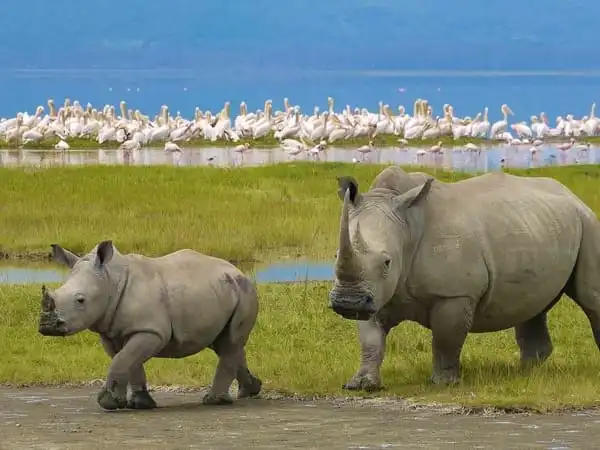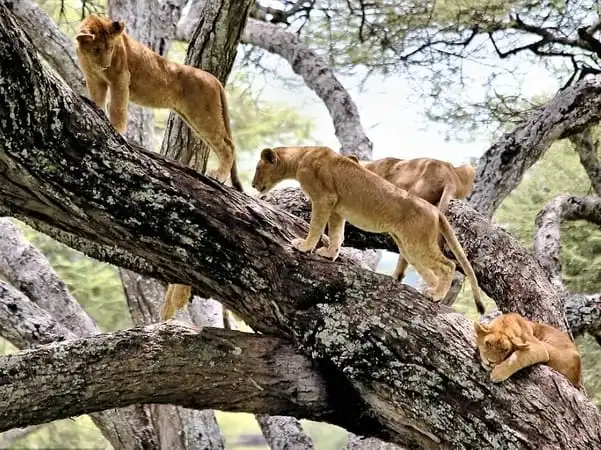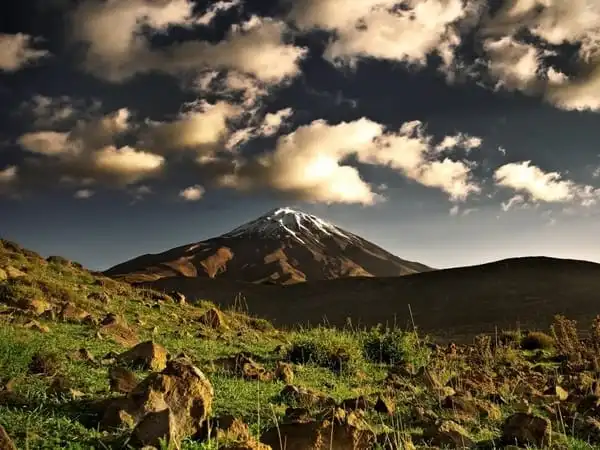Attractions in Tanzania
Tanzania is home to some of Africa’s most breathtaking attractions, from world-famous national parks to idyllic tropical islands. Whether you dream of witnessing the Great Migration in the Serengeti, standing on the rim of Ngorongoro Crater, climbing Mount Kilimanjaro, or relaxing on the beaches of Zanzibar and Mafia, Tanzania offers unforgettable adventures for every traveler. Below, you’ll find the country’s most iconic attractions and destinations.

Serengeti National Park
Spanning over 14,700 km² of sweeping plains, rolling hills, acacia-dotted savannah, and iconic granite outcrops known as kopjes, the Serengeti offers one of the most awe-inspiring landscapes on Earth.
The Serengeti hosts the Great Migration, the largest terrestrial mammal migration in the world. Over 1.3 million wildebeest, joined by hundreds of thousands of zebras, gazelles, and other grazers, move in a dramatic, seasonal cycle in search of fresh grazing and water — followed closely by Africa’s top predators. One of the most unforgettable moments of this journey is the Mara River crossing, where herds plunge through crocodile-infested waters in a desperate bid for survival.
It is home to one of the highest concentrations of large mammals and carnivores anywhere on the continent. The park boasts all of Africa’s iconic big cats: lions, leopards, cheetahs, and spotted hyenas, making it a prime destination for predator sightings. It is also a vital refuge for the critically endangered Eastern Black Rhino and the endangered African wild dog.
With over 28 herbivore species, including elephants, buffalos, giraffes, hippos, eland, and waterbuck, the diversity of wildlife is unmatched. The Serengeti also shines as a birdwatcher’s paradise, with more than 530 recorded bird species, a quarter of which are migratory.

Ngorongoro Conservation Area
Covering 8,288 km², the Ngorongoro Conservation Area is a UNESCO World Heritage Site and one of Africa’s most extraordinary landscapes. At its heart lies the iconic Ngorongoro Crater — the world’s largest intact and unfilled volcanic caldera — formed by the inward collapse of a massive volcano.
This natural marvel, often called the “Big Bowl” by the Maasai (‘orgirra le kkorongorro’), is home to over 25,000 animals, including all of the Big Five: elephants, buffaloes, lions, leopards, and the critically endangered Eastern Black Rhino. Its diverse habitats — grasslands, swamps, rivers, and woodlands — make it one of the best wildlife viewing areas in Tanzania, all within a scenic, compact setting.
To the west, the Ndutu Plains form part of the southern Serengeti ecosystem and play a vital role in the Great Migration. From December to April, massive herds of wildebeest, zebras, and gazelles arrive to calve, attracting predators like lions, cheetahs, and hyenas. These short-grass plains, dotted with soda lakes, marshes, and acacia woodlands, also host resident wildlife such as giraffes, elephants, jackals, and hundreds of bird species.
With its dramatic scenery, ecological richness, and year-round wildlife spectacle, the Ngorongoro Conservation Area remains a safari destination like no other.

Tarangire National Park
Located just a few hours from Arusha, Tarangire National Park is a stunning gem along Tanzania’s northern safari circuit. Covering 2,850 km², the park is named after the Tarangire River, a vital water source that draws thousands of animals during the dry season, making it one of the top wildlife destinations in the region.
Famous for its massive elephant population — often seen in herds of up to 300 — Tarangire offers unforgettable wildlife encounters. Visitors can also spot lions, leopards, cheetahs, giraffes, buffalo, zebras, elands, and more. The park’s iconic baobab trees, some over 300 years old, and the scenic savannah landscape create a breathtaking backdrop for game drives and photography.
Birdwatchers are in for a treat, with over 550 species recorded, including several endemic and threatened birds. Swamps scattered across the park provide rich habitats, making it one of East Africa’s premier birding destinations.
Activities include day and night game drives, walking safaris, hot air balloon rides, birdwatching, bush meals, and picnics. Whether you’re passing through en route to Ngorongoro or the Serengeti, Tarangire offers an exceptional safari experience with remarkable beauty and unmatched wildlife diversity.

Lake Manyara National Park
Nestled at the base of the Great Rift Valley escarpment, Lake Manyara National Park is a compact but diverse gem, covering 648.7 km². It offers breathtaking scenery and rich wildlife experiences, making it an ideal stopover on the way to Ngorongoro and the Serengeti.
The park is famed for its unique tree-climbing lions, a rare behavior that sets Manyara apart. Its lush groundwater forest — alive with baboons, blue monkeys, and bushbucks — opens into grassy floodplains and the alkaline lake, which hosts thousands of flamingos and over 390 bird species, including pelicans, storks, and birds of prey.
Lake Manyara is also home to elephants, buffalo, giraffes, hippos, and elusive leopards, while hot springs heated by volcanic activity bubble along the lake’s edge. The varied habitats — forest, woodland, grassland, and lake — support an incredible diversity of life.
Activities in the park include day and night game drives, walking safaris, birdwatching, canoeing, and the thrilling canopy tree walk — one of the longest in Africa — which offers treetop views of monkeys and birds. Whether you’re watching a lion lounging in a tree or spotting dozens of bird species in a single day, Lake Manyara delivers a unique and rewarding safari experience.

Arusha National Park
Arusha National Park spans 322 km² and is often called a “little gem” thanks to its diverse landscapes and rich wildlife. Dominated by Mount Meru (4,566 m), Tanzania’s second-highest mountain, it’s a great spot for acclimatization before climbing Kilimanjaro.
Highlights include Serengeti Ndogo (“Little Serengeti”), where buffaloes, zebras, giraffes, warthogs, and waterbucks roam freely. The park is also one of the best places to spot the acrobatic black-and-white colobus monkeys.
The Ngurdoto and Meru Craters offer panoramic viewpoints overlooking Momella Lakes, the Kilimanjaro summit, and the surrounding countryside. The Momella Lakes are known for lesser and greater flamingos, while Lake Longil, the park’s only freshwater lake, supports tilapia and floating papyrus islands.
Other attractions include the Fig Tree Arch, the 28-meter Tululusia Waterfall, and the Ngarenanyuki River with its brackish waters.
Activities range from game drives and walking safaris to canoeing, horseback riding, and mountain hiking. With over 450 bird species, it’s also a top spot for birdwatchers.
Compact and scenic, Arusha National Park offers a rich safari experience just a short drive from the city.

Kilimanjaro National Park
Kilimanjaro National Park, covering an area of 1,712 km², is home to Africa’s highest peak — Mount Kilimanjaro — a snow-capped giant rising 5,895 meters above sea level. Known as “The Roof of Africa,” it’s also the world’s tallest free-standing volcano, made up of three volcanic cones: Kibo (dormant), Mawenzi (dormant), and Shira (extinct). While many dream of reaching its summit, the park offers unforgettable experiences even without climbing to the top.
Visitors can explore the mountain’s diverse eco-zones, from lush montane forests to the scenic Shira Plateau, home to migratory wildlife like elephants, buffaloes, and elands. Nature trails, such as the Marangu route, lead through enchanting forests filled with unique flora, including the endemic Impatiens kilimanjari. Lauwo Waterfall, Maundi Crater, and the Kifinika Cultural Site — sacred to the Chagga people — add cultural and natural richness to a visit.
Recognized as a UNESCO World Heritage Site and one of Africa’s Natural Wonders, Kilimanjaro National Park invites visitors to enjoy its beauty through forest walks, birdwatching, cultural visits, and scenic drives — inviting nature enthusiasts to discover its wonders — no summit required.

Zanzibar Archipelago
The Zanzibar Archipelago, off the coast of mainland Tanzania, is a tropical paradise steeped in history and natural charm. Its main island, Unguja — commonly known as Zanzibar Island — is world-renowned for its powdery white beaches, warm turquoise waters, and rich cultural heritage. At the heart of it lies Stone Town, a UNESCO World Heritage Site, where centuries of Swahili, Arab, Indian, and European influences are reflected in the architecture, narrow alleys, and ornate wooden doors.
Once a hub of the spice and slave trades, Zanzibar still evokes the mystique of ancient sultans, dhow sails, and coral-built palaces. Visitors can explore spice farms, visit historic ruins, or simply unwind along palm-lined shores.
To the north, Pemba Island offers a more secluded and verdant escape, known for its untouched landscapes, traditional Swahili villages, and superb diving sites. Throughout the archipelago, idyllic sandbanks, uninhabited islets, and vibrant coral reefs invite snorkeling, swimming, and sailing in the clear Indian Ocean.
Zanzibar’s blend of cultural depth, historical intrigue, and natural beauty makes it one of East Africa’s most enchanting destinations — a perfect complement to a mainland safari or a relaxing coastal getaway in its own right.

Mafia Island
Mafia Island is a tranquil, lesser-known gem off Tanzania’s southern coast, offering pristine natural beauty and an unspoiled marine ecosystem. Ideal for nature lovers, honeymooners, divers, and slow travelers, it promises an intimate, off-the-beaten-path escape far from the crowds.
Island Experiences You’ll Love:
- Diving & Snorkeling in the Mafia Island Marine Park – home to over 400 species of fish and vibrant coral reefs. Expect gentle drift dives, coral gardens, and seasonal sightings of whale sharks (October to March).
- Turtle hatching experiences from June to September and humpback whale sightings August to early October.
- Sandbank picnics, traditional dhow sailing, kayaking through mangrove forests, and guided cultural village tours.
- Birdwatching and marine excursions in a protected, peaceful setting ideal for eco-conscious travelers.
Unlike its busier island neighbors, Mafia offers a slower, more authentic pace of life and deeper connection with nature. The best time to visit is June to March, when marine life is at its most active and weather conditions are ideal. With its warm hospitality, natural charm, and world-class marine life, Mafia Island is a must for travelers seeking a serene coastal escape in Tanzania.
Address
81 Meiroti Street, Oloirien
Arusha, Tanzania
booking@serengetiuntamed.com
info@serengetiuntamed.com
Contact
+255 712 006 364
+255 767 678 898
© 2025 Serengeti Untamed. A trading name of NL Group Ltd. | Privacy Policy | Terms of Service
